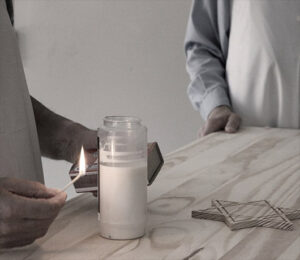A Deeper Understanding
Death is a stage of life, with its own rituals and observances appropriate for that stage, including how we honor the deceased and how we mourn. Jewish death practices help us cope as we witness death and process the depth of trauma in personal and communal life that arises when death occurs. These customs show dignity to our deceased and provide comfort to the mourners. Just as we strive to show respect to each other in daily life, Jewish custom continues this practice by infusing all of our death-related practices with respect and dignity. We consider each person to be a holy being, created b’tzelem Elohim.
Introduction
Each person has within them a holy soul, a spark of the Divine, that animates and gives life to each of us. Our tradition teaches that when we die, the soul lives on independent of the body. Hence, we continue this tradition of honor by giving the same respect to the dead that we give to the living, including care for the dead between death and burial. We go to great lengths to show loving kindness in our death rituals to preserve the modesty and dignity of the deceased between death and burial, as well as in post-burial rituals and prayers.
Everyone dies, and this is expected and viewed as part of life. In every Jewish worship service, we say the Mourners’ Kaddish, a prayer that does not mention death, but is part of the communal ritual by which we support those dealing with a death in their family. This prayer is also a reminder to everyone that life is a gift, one not to be taken for granted. The Jewish life continuum includes aging, dying, death, and mourning — honoring the holiness inherent in each of these stages as threads in the tapestry of life.
Details
Judaism provides a framework for facing death. Both the dead and the living are treated with respect and love. We honor the holiness of life through how we prepare our dead for burial, and Jewish mourning rituals give a structure to help the mourner move through the grieving process and encourage the mourner to face death, move through those times in meaningful ways, and to then re-enter life in a gradual manner. Each step of this process is imbued with respect for both the deceased and a beautiful, insightful understanding of the needs of the mourner – and ultimately, a deep appreciation for the sanctity of life.
Learn more about Jewish mourning practices here.
Jewish end-of-life practices cover a large spectrum of customs and rituals. The actions included in some of these continue as they have been for centuries. While maintaining the spiritual essence, others today include new innovations such as virtual attendance using online technology. For the rituals between death and burial, we continue to honor the holiness of life in both the living and the dead with a special team who cares for our dead. The Chevrah Kadisha is the name of this team that honors the dead through taharah and shmirah. The activities of each chevrah may also include sewing tachrichim, helping to fill in graves at the burial, preparing meals of consolation, leading, or attending shiva services, and helping to educate the community about Jewish death practices.
Learn more about the Chevrah Kadisha here.
What to do When Death Occurs
When there is a death, there are specific things that need to happen, some needed immediately, some arranged more slowly. This is a time for calm action and clear thinking. For an overview of what needs to happen please refer to this list of suggested actions.
Resources to Learn More
- BimBam video: Talking to Kids About Death
- Royal Jewish Heritage Article: Jewish Traditions for Death, Burial, and Mourning
- Learn about the beauty and richness of Jewish death practices through stories written by those who perform these customs; see Jewish Rites of Death: Stories of Beauty and Transformation, by Richard A Light
- The Jewish Way in Death and Mourning, by Maurice Lamm
Jewish practices and rituals contain specific ways of caring for the dead. The central values underlying all of these customs are to provide respect and kindness for the dead and to give comfort and support to the mourners.
Click on icons below to learn about this topic from different perspectives.
Practical
Emotional
Textual
Spiritual


